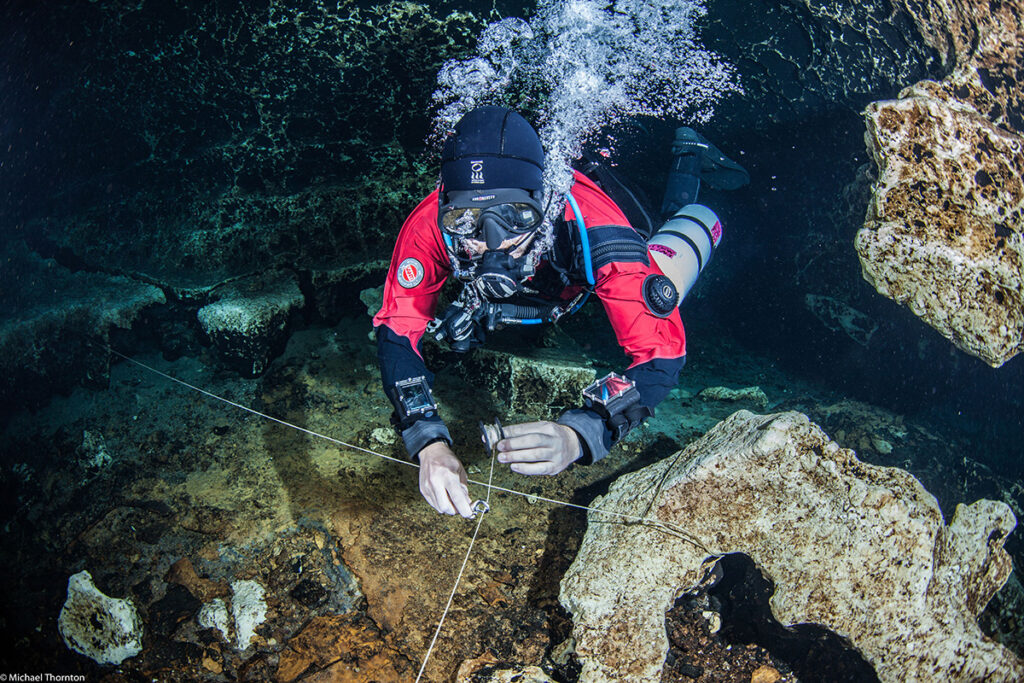Full Cave
Are you a serious adventure seeker wishing to explore overhead environments? Sign up for the TDI Full Cave Diver Course!This course is the third stage of overhead environment training in the series of TDI’s Full Cave Diver Development Program. Advanced cave dive planning, practical execution of different types of cave systems and scenarios divers encounter are presented. This cave diving course is not intended to prepare divers for evaluating all facets of cave diving. The objective of this course is to expand and critique previous skills accomplished in the TDI Cavern and Introductory Cave Diving programs. Emphasis is placed upon dive planning and skill perfection through actual cave penetration.

What you can expect to learn
The TDI Full Cave Diver Course takes an in-depth look at all of the following and more.
- Standard cave diving policies
- Gas management procedures and management to include dissimilar volumes
- Psychological considerations of cave diving
- Equipment considerations including:
- Cylinder options
- Regulator options
- Buoyancy compensator/harness options
- Proper weighting
- Reel options
- Equipment configurations
- Communication (light and hand signals)
- Swimming techniques
- Body posture/trim
- Buoyancy control
- Line following
- Propulsion (finning) techniques
- Physiology
- Breathing techniques
- Stress management
- Decompression theory and its application to cave diving
- Cave environment
- Conservation
- Problem solving
- Emergency procedures
- Equipment failure
- Silting conditions
- Accident analysis
- Cave diving etiquette
Course Equipment Requirements
The following are the required for this course:
- TDI Diving in Overhead Environments Manual (or TDI Overhead eLearning course)
- TDI Diving in Overhead Environments Instructor Guide
Other suggested reading materials:
- Basic Cave Diving – A Blueprint for Survival
- Cavern Measureless to Man
The following equipment is required for each student:
- Dual cylinders, volume appropriate for planned dive, student gas consumption
- Two independent first and second stage regulators; one regulator equipped with a long hose at a
- recommended minimum length of 2 metres / 7 feet
- Submersible pressure gauge
- Buoyancy compensator device (BCD) with power inflator
- Exposure suit adequate for diving environment
- Mask and fins
- Two line cutting devices
- Three battery powered lights; 1 primary and 2 back-ups, each with a with burn time suitable for the planned dive time
- Safety reel/spool with a minimum of 37 metres / 125 feet of guideline. A second safety reel/spool is recommended.
- One primary reel for the team with length appropriate for intended dive
- Computer, watch or bottom timer and depth gauge
- Slate or wet notes with a pencil
- Submersible dive tables or back up dive computer
- Three directional line arrows
- One non- directional line marker
- Reel(s)/spool(s) with sufficient guideline for planned jump(s) or gap(s).
- It is recommended that the team properly mark decompression cylinders and stage them, in any dive where decompression is planned, at least 1 stop deeper than the planned decompression obligation Instructor must use full cave diving equipment during all
Course Prerequisites
- Minimum age 18
- Minimum certification of TDI Introductory Cave Diver, or equivalent
- If decompression dives are to be conducted in training, the student must be TDI Decompression Procedures certified or equivalent, or this training may be conducted concurrently. If courses are taught concurrently, ALL requirements for both courses must be met and registrations processed upon completion.
Want to know more?
Ask more questions or schedule any of these courses Email Us.
